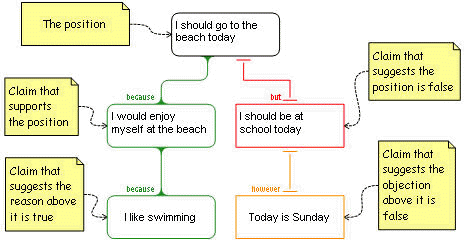The Science Of Scientific Writing Set 1 Set 1-Argument Parts : Second Page : Third Page : Example : Exercise 1 : Exercise 2 : Exercise 3 : Exercise 4 : Exercise 5 : Final Page - Set 1.
OVERVIEW: The way to well-written science
PART I: Paragraphs and Sentences
SET A: Paragraphs: The Maps Behind Them
SET B: Paragraphs: Using Maps to Meet Readers' Expectations
SET C: Paragraphs with Something Extra: Points and Tails
SET D: The Generic Section: Expectations and Maps as Blueprints
SET E: Scientific Sections: The Methods and Results
SET F: Scientific Sections: The Discussion
SET G : Scientific Sections: The Introduction
SET H : Sentences
SET I : The Paper as a Whole
PART II: The Paper and its Sections
SET 1: Argument Parts
SET 2: Indicator Words
SET 4: Locating Arguments in Prose
SET 5: Rationale's Essay Planner
SET 6: Evidence in Arguments: Basis Boxes
Synthesis 1: Position-Early Paragraphs
Synthesis 2: Position-Final Paragraphs
Synthesis 3: Writing a Discussion I
Synthesis 4: Writing a Discussion II
We can use reasoning maps to show how reasons, objections, and rebuttals fit together in relation to some position.
Consider this train of thought:
Maybe I should go to the beach... I'd enjoy myself if I went. On the other hand I'm supposed to be at school today. I really enjoy swimming though...
People often think and talk this way, but the structure of their reasoning isn't very clear when we look at it in written form. The piece of reasoning in the box above is fairly short and simple, but imagine how hard it would be to follow if it were ten times longer!
An argument map makes the structure much more clear:

Below is a more typically scientific argument with exactly the same architecture:

One of the pleasing features of an argument map is that whether we agree or disagree with the points being made, at least we know with complete clarity each component's intended role. We can see at a glance how each component fits into the larger pattern of reasoning. The burden of navigating a complex argument has been greatly reduced. Later, one of our major goals for a written argument will be to reduce its navigational burden. As a scientist, convincing your audience of your point is not actually as important as convincing them that you are an intelligent, diligent and trustworthy investigator. In this regard, nothing influences the impression you make more than your arguing style.
In sets 1-5 you'll be learning how to show the structure of reasoning using Rationale. We'll build your skills step by step, until you're creating your own maps with confidence.
Content of this page drawn in whole or part from the Austhink Rationale Exercises with permission from Austhink.